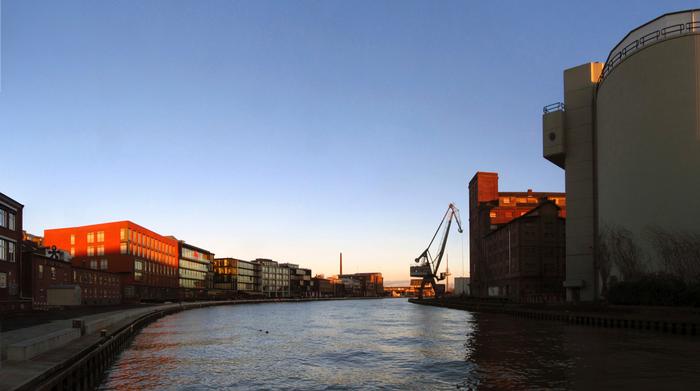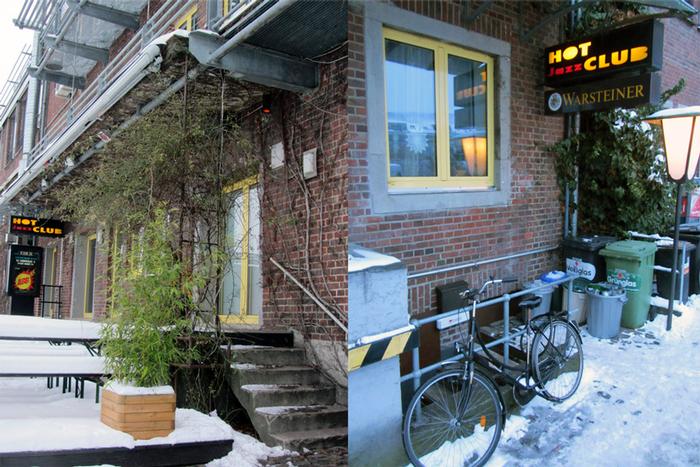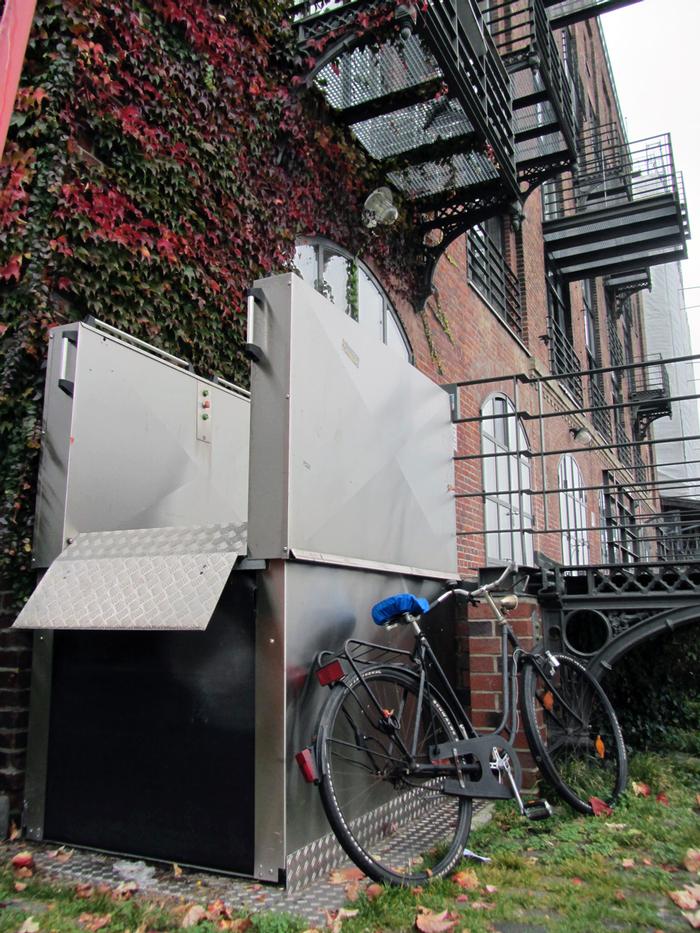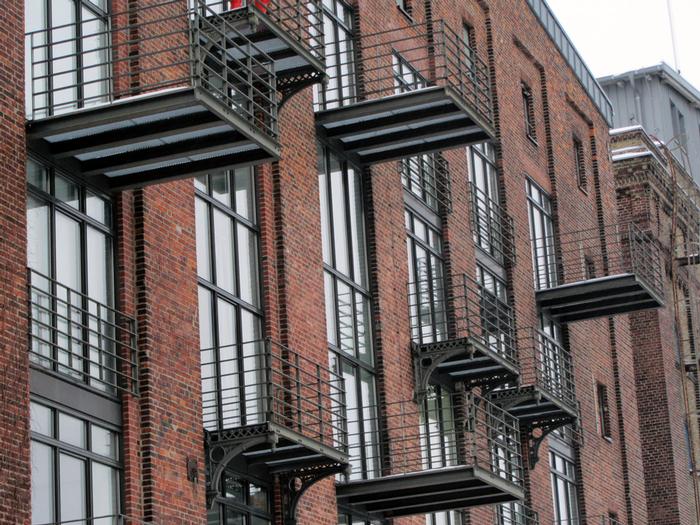[ID:650] Münster - World´s most livable city, but for everyone?Germany When one hears the term “harbor”, different connotations are associated with this word. One is reminded of their own experiences in harbors: the last cruise, last car ferry crossing a lake or the sea food dish in the fishing port. Perhaps you might think about the film “On the waterfront” that shows the port as a filthy, lawless place.
Münster’s harbor does not meet these expectations. It is a river port connected to a canal. It was built in 1899 when Emperor Wilhelm II inaugurated it. For a while it was a trading centre for grain. Over the years, however, the transhipped goods in the port decreased. After World War II the port was supplied with materials to rebuild Münster. The current situation is different. The port has lost its original meaning and words like “creative pier” or “harbor scene” are now synonyms for a service and gastronomically used sector unique in Münster and its environment. Old depository warehouses and hubs were demolished to give space for new, modern and innovative buildings. In the course of the harbor transformation the visual nature of a few buildings was left unaltered as part of a preservation order. Now they are perfectly integrated in the magnificent view of the waterfront.
The aim of the restructuring and rescheduling was a revitalization of the quay and the surrounding area with a cinema complex, a nightclub district and many public services.
The attitude of life in the summer at this new hip part of town is a special one. While you can see some people on the quay wall enjoying their beer, dangling their legs into the water pools, on the other side of the pool youngsters are hanging out with ghetto-blasters. Exclusive bars alternate with vintage bars and at the city beach you can relax and listen to hot salsa rhythms while enjoying cocktails. Later in the evening you can experience yet another amenity, the disco, which is integrated in an old warehouse and always guarantees great fun. The sound of the saxophone, which comes out of the “Hot Jazz Club”, induces a quiet end of the evening. Funky music in a cosy atmosphere of the renovated store is guaranteed. Unfortunately not for everyone….
“Our Jazz Club is not accessible for disabled. There are stairs inside and the doors are too small since the building is a very old one.” This is just one of many negative answers we received in the bars, restaurants and discos as we asked for a possibility to get in with a wheelchair. The absence of elevators and ramps makes it difficult or impossible to enter. We had to find that on the inside the next barriers are waiting for physically challenged people: Suitable restrooms and any other auxiliary mean like a menu in Braille or written in big letters cannot be found. Therefore experiencing and enjoying the restaurants and bars is impossible for those with physical limitations. How can someone enjoy a glass of wine or a cocktail if they are worrying about where to find a toilet to use? Even a public restroom for physically disabled people is not available in the harbor area.
Almost every student in Münster is told during the first weeks at the university that they are lucky to study in the “most livable city in the world”. At least that’s the title Münster was accredited with by the United Nations Environment Program through the annual LivCom-Award (in the category 180.000 to 250.000 inhabitants in 2004). But the results of our research made us question if Münster deserves this award also judged from a handicapped person’s point of view. If you might suppose, more than one affected person asked this question reacted with a definite “no”. So we began to wonder how to change the area around the harbor to bring this “no” closer to a “yes”.
“I´m sorry but the building is a very old one at the harbor.” That´s what the employee of the Jazz Club we had met told us to give a reason for the non-accessibility of the redesigned granary the Club is located in. In this way he expressed the assumption that suitability for disabled and the conservation of old buildings are two opposing architectural poles damned to never be united. Also, among the challenged people we talked to, the idea that their discrimination is the price to pay for the antic face the town is famous for was very common. Consequently one can ask: Is it impossible for Münster to become the most livable city for everyone?
Since World War II, rebuilders have done their best to restore Münster to its pre-war appearance. Today the results of this attempt define the townscape and make a big contribution to many peoples’ satisfaction with the town. But in some parts of Münster this attempt and the will to satisfy and include every individual is expressed at the same time. In the inner city, for example, some good solutions to make it more accessible were found:
Very significant for this area is the cobbled street, which underlines the inner city´s antic impression, and which slows the traffic so that pedestrians can cross the street safely. But for people using a wheelchair, a walking frame or a white cane, it is an obstacle making it difficult to cross the street. The gaps between the stones can make small wheels get stuck, challenge an individual’s balance, or even twist an ankle. To avoid this problem, at important crossovers the cobbled stone was replaced by a road surface, which adapts the road to become more passable. Furthermore, you can find ramps in front of important buildings or in front of little bars where you can still mention the spirit of the times of the civil rights movement. Public toilets for disabled have been built; important monuments and sculptures contain information in Braille. Low-floor buses with integrated ramps, making it possible for everyone to go from A to B in a short period of time. For example from the inner city to the harbor area, where you cannot recognize the spirit of inclusion at first glance. But even in this area a proof for the compatibility of inclusion and conservation can be found: The museum “Kunsthalle Münster”.
In this museum you can see what can be done for accessibility without destroying sensible parts of an old building. In 2004 the “Kunsthalle Münster” moved into this old granary which exhibits modern art. They installed a large elevator and on the outside a hydraulic platform to carry the visitors into the building. Now it is possible for everybody to experience modern art. They also added balconies on the facade to the waterfront, which are also accessible and usable for people depending on a wheelchair or a walking frame.
When restoring an old building the will to save the original appearance of the work of architecture and the will to pay attention to accessibility often conflict. Sometimes it is necessary to impose certain restrictions on owners and architects to guarantee a professional historic preservation. But these restrictions should not result in a reduction of physically challenged peoples’ possibilities to lead and experience their lives, because architecture is made to serve humans. Every human. Once expressed perfectly by Adolf Loos, a famous Austrian architect: “The house has to please everyone, contrary to the work of art, which does not. The work is a private matter for the artist. The house is not.”
Such architecture, which fulfills not only the historic preservation requirements but also every human’s needs already exists in some regions of our town and in a limited part of the harbor area. But in our opinion this little part is not enough and the question “What more can be done?” comes to our minds.
To answer this question we would like to invite you to a journey to the future - accompanying a wheelchair driver:
One nice winter afternoon I toy with the idea of going out for some fresh air. While I’m driving through the streets I notice that I haven’t been at the harbor since the summer of 2013. I really like the port, but I avoided it the last time because of my wheelchair. The port was not accessible for disabled and it frustrated me not to be able to reach all of the areas.
But now I’m making the decision to take a ride to the harbor. Reaching the port, I’m a little bit surprised by the silence. But yeah, it’s winter and the harbor is only rarely visited. In the summer, the area looks very different because of a promenade full of people and students chilling at the city-beach. Suddenly I recognize something awesome. They removed the bumpy cobble stone pavement and replaced it with new flat paving stones. These new stones don’t destroy the vintage image of the port and help me to move forward comfortably. So I cross the border from the tarmac to the new ground and glide smoothly along the harbor basin. By the way I notice that the new ground is not the only novelty. The concrete benches right on the waterfront have been modified. The benches were previously always connected by concrete stages, because of visual and aesthetic reasons. They generate the impression of a zigzag pattern, a kind of a swinging band. This, however, was removed so that now people can park directly beside the concrete benches with their walking frames and wheelchairs in addition to swing themselves comfortably on the bench. Just great! As I just note that basically the whole promenade was restored, I finally understand that the project “Accessibility 2013” has born fruit.
On the left side, there are still the restaurants and bars with wooden terraces in front of them. But now these terraces are connected and big ramps offer an alternative to the stairs at their ends. “Amazing”, I think and head towards one of them. It´s just passed four o’clock, the right time for a cup of coffee. After gaining momentum I reach the rostrum halfway up the ramp, where I can take a little break before going on. Now I´m on the terrace and without exertion I find and push a button, which makes the doors of the “Pier 7” slide open. Immediately a waiter asks me to help me take off my jacket. Neither a note of pity nor the expectation of my mental incapacity, I´m unfortunately often confronted with, were in his voice as he spoke.
The café is crowded and the waiter brings me to a table, which is high and wide enough to place my legs under the tabletop in a comfortable way. He explains to me, that he is sorry that I can’t choose every free table in the restaurant like everyone else. He assures that they are going to replace the furniture, which people dependent on a wheelchair can’t use in an adequate way, as fast as possible. Change takes time. At least the restrooms, which are also suitable for me, are near the “disabled table”. As I take the menu in my hand, my fingers feel little bumps. Braille, I think. Even though I’m not visually impaired I feel comfortable with spending my time at a place, where you try to include every person.
After having a cup of coffee in the “Pier 7” I leave the restaurant by the lift at the back entrance and continue on my way down the promenade. Passing the Hot Jazz Club a big poster invites to join the concert of the Glenn Miller Band this evening. It says: “Big tribute to Glenn Miller and Band. Broadcast on big screen in the first floor.” While seeing this I remember an earlier conversation with the owner of the club, who was forced to refuse my entry because there was no elevator going down to the jazz cellar. Also disabled toilets were not provided at that time. He said that the house was landmarked and an elevator installation impossible. But when I now read that the live show will be transferred from the basement to the first floor I’m completely thrilled. The first floor is accessible so it’s no problem to join the show.
Suddenly my vibrating cellphone interrupts my thoughts. It’s a fellow student who I have the urge to tell my new impressions, thrilled by the innovations of the harbor. He says he already knows it. For him, the most fascinating aspects are the information points for visually impaired on the ground. As I look down, I immediately see what he means. He explains that these information points are transmitted to the visually impaired’s white stick. The white stick is connected with the Bluetooth headset the person wears. Information like the next construction side coming up in a short distance is relayed by a friendly voice. Now I’m definitely overwhelmed. At that moment I wish that the whole city would be designed like this. Such a comfort for everyone.
What a nice prospect, isn’t it? As mentioned above the situation is still different: No information points, no menus in Braille, no ramps, no lifts, no public or private restrooms suitable for disabled, no elevators, no flat paving stones, no gaps between the concrete benches can be found in the harbor area in reality.
During the historical development of our town the harbor oftenly played a significant role and today the antic impression takes the responsibility of telling this story to the visitors. Maybe at first glance, conserving this impression and including every person by architecture seem to contradict each other. But at second glance even in some places of our town it is proofed that these attempts can be brought together. The next thing to do is to increase the amount of accessible places, especially in an area like the harbor, which you prefer to avoid as a disabled person. In the case that a compromise between historic conservation and inclusion by architecture cannot be found, in our point of view the inclusion should have the higher priority. Architecture should serve everyone. As naturally as this “everyone” also refers to disabled people, challenged humans should be included in the society and also in the process of creating architecture. Especially considering the demographic development in the industrialized countries and the increase of the citizens’ age average, we have to wake up and face this problem.
This essay has energized us to try to take a first step in this direction. On the website “wheelmaps.org” you can post if a public or private place is accessible or not. Studying the map of the area around the harbor, we recognized that information was missing. Even though in this moment we don’t have the possibility to change the architectural situation, at least we want to simplify disabled peoples’ lives and reveal the deplorable state of affairs. Therefore we completed the information about the harbor area. Now, red signs on the map offer the necessary information of the non-accessibility of the buildings and ask everyone to act.
If you would like to contact this author, please send a request to info@berkeleyprize.org. |




